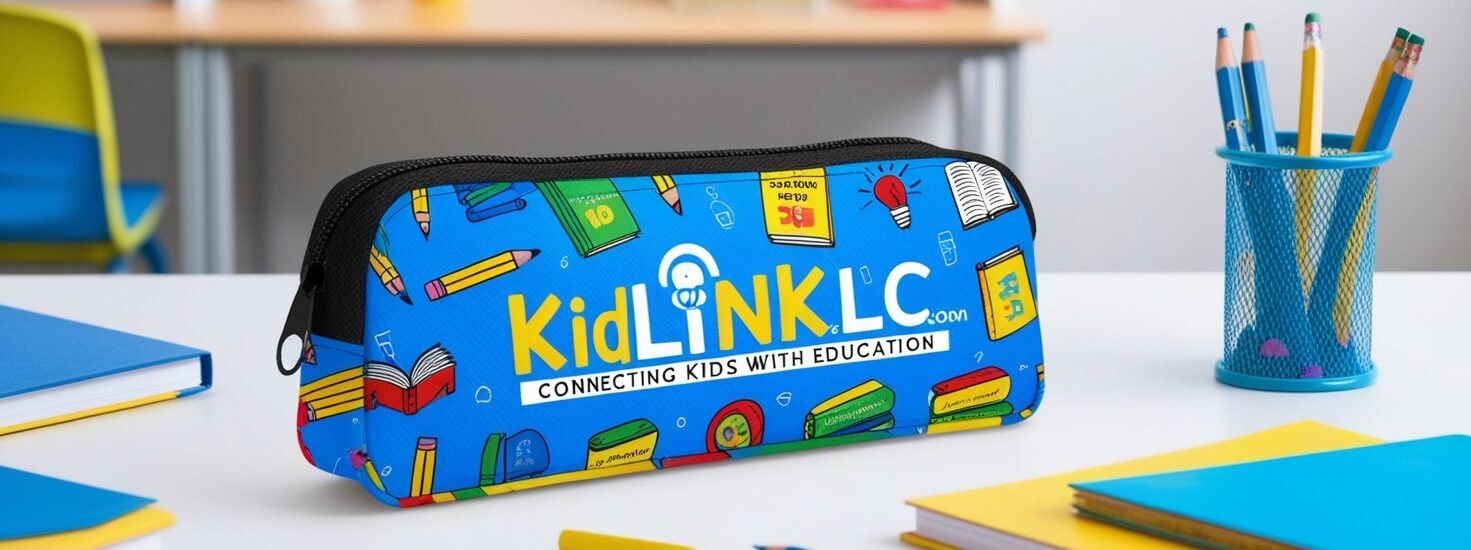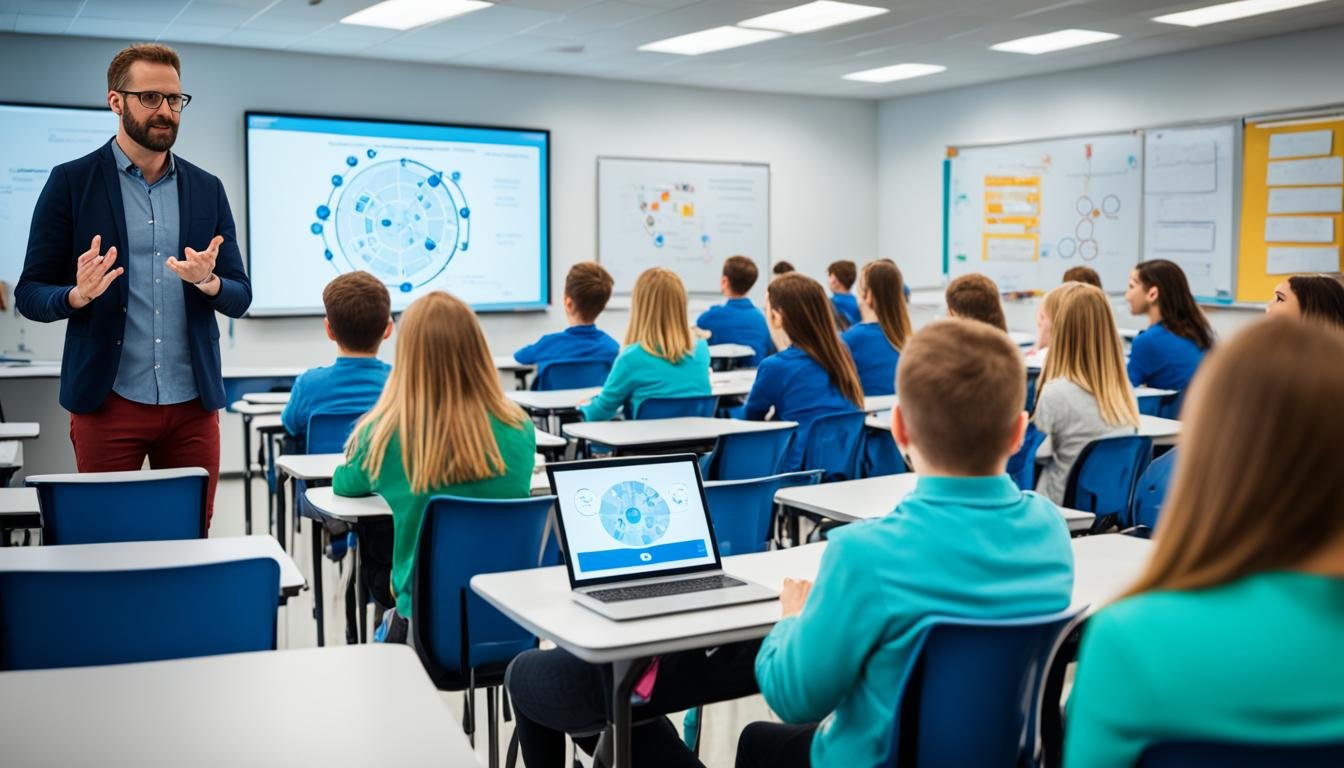What Role Does Technology Play in Modern Education, and How Can Parents Best Utilize It?
Have you ever thought about if your child’s school experience is as good as it could be in today’s tech-filled world? Technology has a big impact on modern education, and as parents, we have a key role in using these tools to help our kids learn better. With so many digital tools available, it’s important for us to learn how to use them right to support our children’s education. Using educational technology makes learning fun and gets our kids ready for the digital future ahead.
Key Takeaways
- Technology changes how we learn, making it more engaging and effective.
- Parents are crucial in adding educational technology to our kids’ daily learning.
- Digital tools offer learning experiences that fit each child’s unique needs.
- Keeping up with the latest in tech in education helps parents make smart choices.
- Looking into platforms like KidLinkLC can give more learning resources for kids.
- Working together with teachers and parents leads to better learning results.
Understanding the Landscape of Modern Education
The modern education scene has changed a lot thanks to technology. Now, technology makes learning fun and interactive. Students do better when they use digital tools, making school more exciting.
As a parent, I see how tech changes my child’s learning. Schools now use new teaching methods thanks to the digital learning revolution. Teachers use online lectures, apps, and interactive platforms to make learning better.
Knowing how tech affects education helps me help my child. Even with issues like not having enough devices or internet, the good parts win. I’ve seen how tech helps students talk and work together better. It’s key to get kids ready for a digital future.
It’s important to keep up with these changes. Reading articles like this helpful piece helps me. It gives tips on creating a good learning space at home and supporting my child’s school needs.
The Importance of Technology in the Classroom
Exploring technology in today’s classrooms shows its huge role in improving learning. It gives students quick access to information, changing how they see lessons. This quick info access sparks curiosity and helps them understand topics better.
Access to Information in Real-Time
Students can now get information as it happens. This makes learning more relevant and creates a lively classroom. Imagine a history class where students can instantly check reports, videos, and social media. This speed boosts their memory and helps them think critically about what they find.
Enhancing Student Engagement Through Digital Tools
Digital tools are key in today’s classrooms, making students more involved and work together better. Tools like interactive software and digital whiteboards make learning more engaging. When I see students doing quizzes or projects together with these tools, it’s clear. These tools turn learning from just listening to exploring and sharing ideas.

| Technology Tool | Purpose | Impact on Engagement |
|---|---|---|
| Smartboards | Interactive presentations and lessons | Increases participation during classes |
| Educational Apps | Personalized learning experiences | Enhances motivation and interest |
| Virtual Classrooms | Remote learning opportunities | Encourages collaboration among students |
Using technology in the classroom gives us strong tools and sparks students’ love for learning. Combining real-time info access with tools for engaging students opens new ways to explore, be creative, and get ready for a tech-filled future.
Technology Integration in Educational Settings
Adding technology to schools can make learning better in many ways. It lets students follow paths that fit their needs best. By understanding how to use technology well in class, I can make education richer for everyone.
Defining Technology Integration
Technology integration means adding digital tools and resources to the classroom in a way that’s engaging and meaningful. It’s about using tools like online tests and digital ways to work together in daily lessons. The aim is to turn old-school classrooms into places where students can be creative, think deeply, and work together.
Examples of Technology Integration
There are many ways technology is being used in classrooms today. Here are a few examples:
| Technology Tool | Application | Impact on Learning |
|---|---|---|
| Google Classroom | Assignment management and feedback | Streamlined communication between students and teachers |
| Kahoot! | Interactive quizzes and assessments | Increased student engagement and motivation |
| Edmodo | Learning management system for collaboration | Enhanced peer-to-peer interactions |
| Seesaw | Digital portfolio for student work | Opportunities for reflection and feedback |
Looking into the benefits of educational tech, I see it helps students grow academically and prepares them for the future. Exploring the world of internet-based education shows how technology can change education for the better.
Technology in Modern Education: Tools and Platforms
In my journey through modern education, I’ve seen how important tools and platforms are. They change how we learn. E-learning platforms and educational apps make learning better and easier to get into.
Popular E-Learning Platforms
Platforms like Khan Academy, Coursera, and Udemy let me learn more than in a classroom. They have lots of resources for different ways of learning. I can pick courses that match my interests and learn at my own speed.
Utilizing Educational Apps
Educational apps have changed how I learn. They make learning fun with interactive exercises and give me feedback right away. Apps for math, languages, and more make learning personal and help me get better.
Blended Learning Approaches
Blended learning mixes classroom learning with online tools. This way, I can learn at my pace and still get help from teachers and friends. It fits different learning styles and gets me ready for a digital future. I use resources like terms of use guidelines to learn how to use digital tools right.
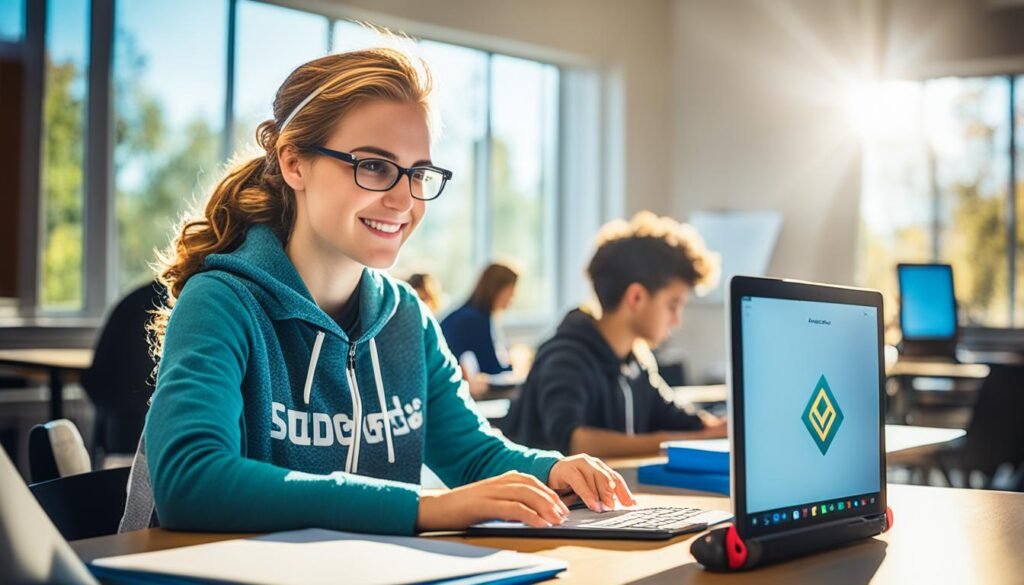
| Platform/App | Description | Benefits |
|---|---|---|
| Khan Academy | Free online courses and practice exercises | Personalized learning paths, extensive subject coverage |
| Coursera | Online courses from universities and companies | Access to top-tier educational content, flexible scheduling |
| Duolingo | Language learning app with gamified lessons | Engaging approach, effective retention strategies |
| Quizlet | Study tool with flashcards and games | Collaboration opportunities, customizable study sets |
Using these e-learning platforms and apps helps me get the skills and knowledge I need. With the right blended learning strategies, I feel ready to handle the challenges of modern education.
Benefits of Educational Technology for Students
Educational technology is changing how we learn, offering new ways for personalized learning. Tools and platforms now meet the unique needs of each student. They help students learn at their own speed.
Personalized Learning Experiences
Adaptive learning technologies show the power of educational technology. They change content and tests based on how well I do. This way, each child can work on what they need to improve.
Personalized learning helps students understand and remember information better.
Improved Learning Outcomes
Using technology in school makes students do better. Studies show that regular use of educational tools leads to better grades. Technology makes learning fun and rewarding by offering interactive materials and tracking progress.
| Method | Benefit | Impact on Student Outcomes |
|---|---|---|
| Adaptive Learning Tools | Customized content delivery | Increased understanding and retention |
| Interactive Simulations | Hands-on experience | Improved critical thinking skills |
| Online Assessments | Immediate feedback | Enhanced performance tracking |
| Collaborative Platforms | Group learning opportunities | Boosted engagement and motivation |
Technology in schools brings more than just better grades. It makes my children love learning more. Advances like personalized learning and better student results show how important technology is in their education.
How Parents Can Support Technology Use in Education
As a parent, I’ve learned my role goes beyond just cheering on my child. It also means being active in their tech-filled education world. Knowing how to use technology in education is key. Keeping up with classroom tech helps me help my child more.
Staying Informed About Classroom Technologies
Learning about classroom tech helps me see how it makes learning better. I talk with teachers and other parents to find out about new tools. This includes things like interactive games, online grading, and educational apps. By talking about educational technology, I can use these tools at home too. This way, I’m supporting educational tech at home.
Encouraging Responsible Internet Use
Teaching my child to use the internet wisely is crucial. I teach them about being safe online and how to check facts. This helps them be smart users of technology and good digital citizens. By teaching them to use the internet responsibly, they develop a healthy relationship with tech that helps their learning.

| Key Actions | Benefits |
|---|---|
| Stay informed about classroom technologies | Enhanced support for your child’s learning |
| Discuss educational tools with teachers | Alignment of home and school learning experiences |
| Teach digital citizenship | Fosters responsible internet use |
| Engage in open conversations about online activities | Promotes trust and understanding |
Creating a Tech-Friendly Learning Environment at Home
Setting up a tech-friendly learning area at home helps my kids learn better. I pick educational tools that make learning fun and effective. This setup helps them focus and avoid distractions.
Choosing the Right Educational Tools
It’s important to choose tools that match my kids’ interests and goals for tech-friendly learning at home. Here are some tips for making good choices:
- Interactive learning platforms that keep students involved.
- Apps and software that fit different learning styles.
- Age-appropriate content for each stage of development.
- Tools that encourage creativity, like coding or art apps.
Setting Up Digital Learning Spaces
Having specific areas for digital learning helps my kids stay focused. Here’s how I set them up:
- Keep the workspace away from TVs and busy spots in the house.
- Make sure the seating is comfy and the lighting is good to prevent eye strain.
- Use shelves or bins to keep things tidy and easy to find.
- Balance screen time with other activities for good health.
By choosing the right tools and setting up good learning spaces, I’m making learning at home productive and fun.
The Role of Parents in Monitoring Digital Learning
As a parent, I know how key it is to watch over digital learning. In our tech-filled world, it’s vital to keep a balance between screen time and other activities. By being involved, I can make sure my kids use tech wisely and avoid distractions.
Establishing Guidelines for Screen Time
Setting clear screen time guidelines is a must in my home. These rules help my kids know how much time they should spend online versus offline. I want to help them live a balanced digital life with learning, play, and rest.
By setting specific times for educational activities, I teach them to handle digital learning well.
Using Parental Control Tools
Using parental control tools has made it easier for me to watch over my kids’ online activities. These tools show me the websites they visit and the content they see. I feel at ease knowing I can block harmful content and support learning online.
This step is key in my effort to monitor digital learning and keep my kids safe online. For more tips on parents’ role in education, check out this resource.
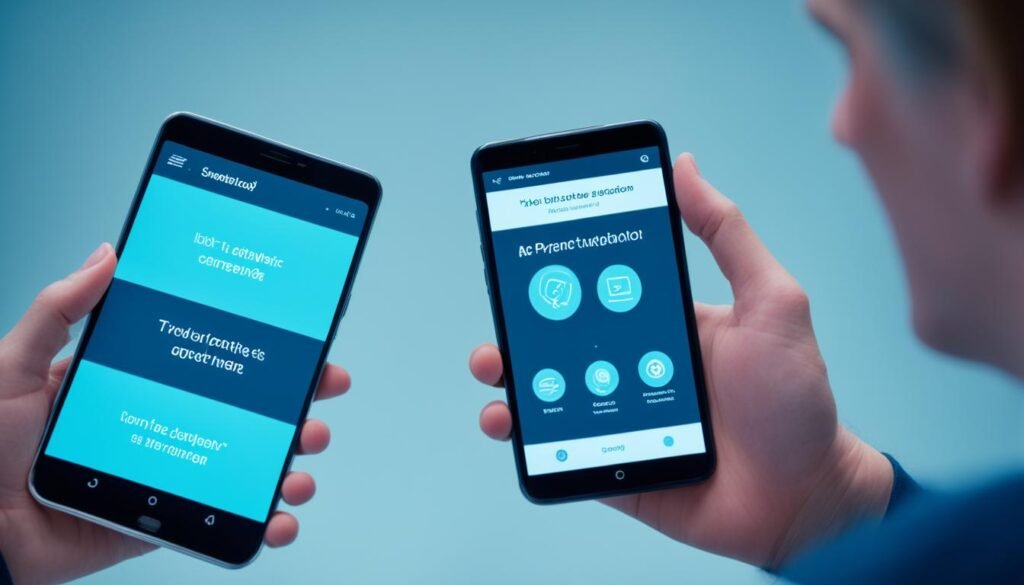
Impact of Technology on Different Learning Styles
In today’s fast-changing education world, *technology and learning styles* are key. They shape how we teach and learn. With many tools and platforms, we can make education fit different learners in tech. This makes sure everyone, no matter their learning way, can do well.
Tailoring Education for Diverse Learners
Technology has many resources for different learning styles, like seeing, hearing, and doing. For example, multimedia shows help visual learners, while podcasts are good for those who like to listen. This way, teachers can meet the needs of all students well.
By welcoming diverse learners in tech, teachers can make learning personal and powerful. It helps students get excited and feel strong.
Creating Inclusive Learning Environments
It’s key to make learning places where everyone can do well. Using tech like speech recognition, captions, and interactive simulations helps students of all kinds. These tools close gaps and make students talk more with each other. This makes learning inclusive in classrooms.
Schools using *technology and learning styles* aim to give students a wide range of learning experiences. This way, all students can fit in.
Thanks to this new way of teaching, teachers move from old methods to a more flexible way of teaching. For more on how tech has changed education, check out this link.
Fostering Collaboration Through Technology
Today, technology is key in helping students work together. When students do group projects online, they learn more and get ready for the real world. This is how they learn to work with others in jobs.
Encouraging Group Projects and Online Interaction
Group projects work better with tools that let everyone edit and talk in real time. Google Docs and Eduflow let students work on the same document at once. This makes sharing ideas and resources easy.
Collaboration through technology helps students learn from each other. They give feedback and support, building a strong community.
Utilizing Virtual Classrooms for Remote Learning
Virtual classrooms are now common in online learning. They make it easy for students and teachers to interact. This makes learning fun and engaging.
These online spaces help students stay connected and work together. They can talk about topics, do group tasks, and understand their lessons better.
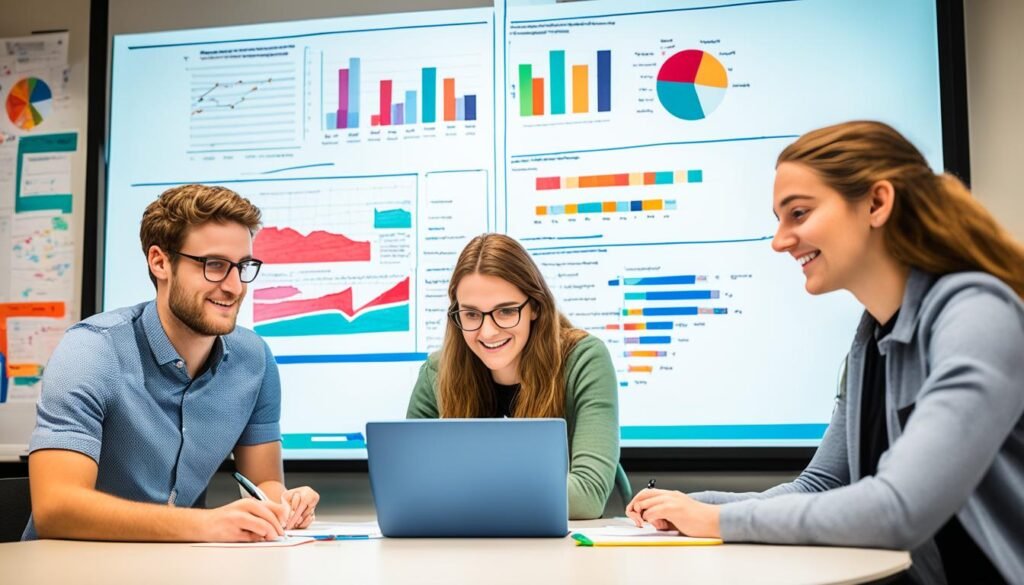
Using these new tools, we can make learning more about working together. For more info, check out how technology is improving feedback and teamwork among students. This will help teachers and students use technology to learn together better.
Evaluating the Effectiveness of Technology in Education
At times, I think about how technology affects education and student success. It’s important to look at key metrics to see how well students do and how engaged they are. By using various tools and strategies, teachers can get valuable data. This data shows how students react to learning online.
Measuring Student Engagement and Performance
One way to check student engagement is by looking at different metrics. Learning management systems give us info on how often students join in, how long they work on tasks, and if they finish them. These numbers are key to seeing if tech in schools works well.
When students are more involved, they tend to do better. It’s interesting to see how tech can make learning more lively. It meets the needs of different students in new ways.
Addressing Potential Drawbacks
Technology has many good points but also some challenges. In my view, tech issues in class can come from distractions or not all students having equal access. For example, technical problems can stop a student from fully taking part in lessons.
It’s vital to tackle these problems to make sure tech helps learning, not hinders it. Schools and teachers must work hard to create a digital space where tech boosts learning, not causes trouble.
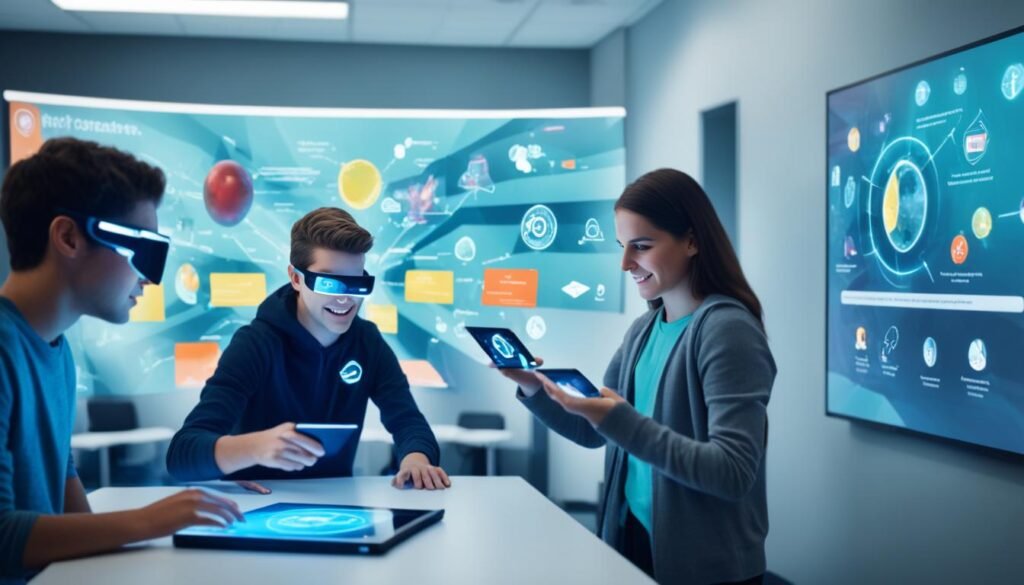
Innovative Teaching Methods Enhanced by Technology
In today’s schools, new teaching methods are key to keeping students engaged and improving their learning. Technology brings new ways to teach, making classes both effective and fun.
Gamification in Education
Gamification makes learning fun by adding game elements to the classroom. It gets students to take part more, turning lessons into exciting adventures. They earn rewards, tackle challenges, and compete in a friendly way.
This makes them more motivated and interested in their studies. Gamification makes hard subjects more enjoyable, making learning a fun journey.
Project-based and Inquiry-based Learning
Technology in project-based learning lets students explore subjects deeply. They learn skills like critical thinking, teamwork, and creativity. They work on real projects that need research, investigation, and presentation.
Inquiry-based learning goes hand in hand with this. It lets students ask questions and find answers on their own. Together, these methods make classrooms lively places where students take charge of their learning. This leads to better retention and understanding of what they learn.
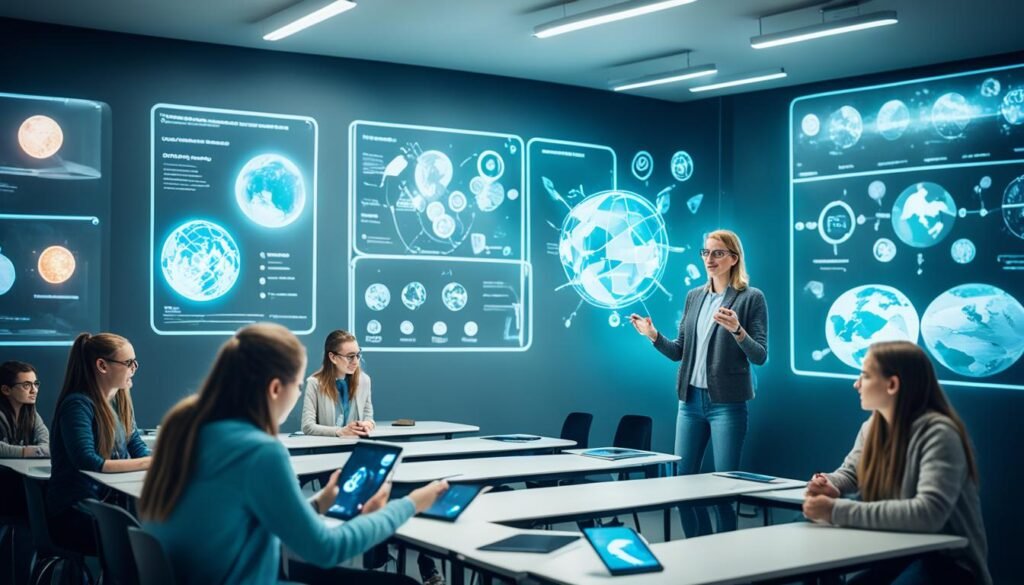
Future Trends in Educational Technology
The world of education is changing fast, and it’s exciting to see what the future holds for educational technology. New EdTech trends are making learning different and more engaging. Technologies like artificial intelligence, virtual reality, and machine learning are making learning more personal and fun.
Emerging EdTech Solutions
Artificial intelligence is changing how we learn. It lets educational tools adapt to what each student needs. This means students get the right level of challenge and help. Virtual reality also brings learning to life, letting students dive deep into topics in a way that’s visually stunning.
Digital Transformation in Education
The move to digital education is making learning more interactive and lively. It’s creating spaces where students can work together and take an active role in their education. This new way of learning gets students ready for a world filled with technology. It also helps them think critically and solve problems, skills they’ll need in the future.
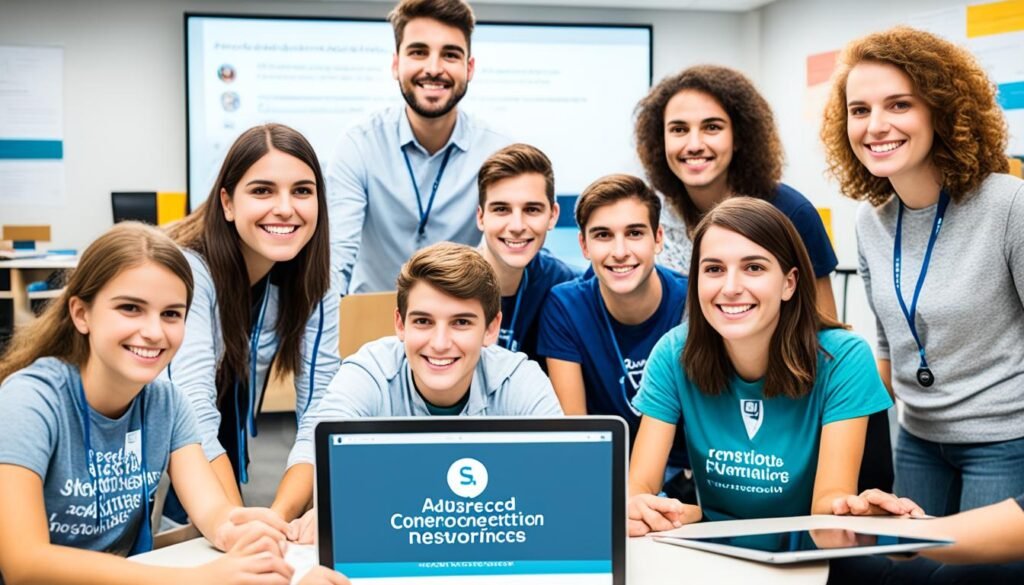
Potential Challenges of Technology in Education
As I look at modern education, I see big challenges with technology. One big issue is the digital divide in education. This means some students can’t get to the resources they need because they don’t have internet or devices. This leads to unfair learning chances for them.
Addressing Digital Divide Issues
To fix the digital divide, we need teamwork from teachers, policymakers, and communities. We should create programs that give devices and internet to students who don’t have them. This way, we can make learning fair for everyone. It’s important to make sure technology stays accessible for all students so they can do well.
Managing Distractions in Digital Learning Environments
Another big challenge is keeping students focused because of technology distractions. Digital tools can help learning, but they can also pull students away from important tasks. We need to find ways to reduce distractions to keep students on track and productive. By setting clear rules for technology use and creating a good learning space, students can reach their full potential.

The Role of Educators in Implementing Technology
Educators are crucial in making technology work well in the classroom. They must keep growing and adapting to use new tools that make learning better. This includes professional development for teachers and working closely with IT experts.
Professional Development Opportunities
Professional development is key for teachers to handle technology in today’s classrooms. Workshops, webinars, and online courses teach the latest in technology. These experiences increase confidence and encourage a culture of ongoing improvement among teachers. Some top choices for professional growth are:
- Hands-on workshops focusing on specific tools like Google Classroom and Microsoft Teams.
- Online courses that cover best practices for blended learning strategies.
- Conferences that highlight emerging technologies and their applications in education.
Collation with IT Specialists
Working with IT specialists is also vital for successful technology use. These partnerships help solve the challenges of introducing new systems and tools. IT pros can help with technical issues and share knowledge on software and hardware that fits teaching methods. This teamwork can happen in different ways, such as:
- Regular meetings to check on technology needs and how resources are used.
- Joint training for teachers and students on new tech.
- Creating a feedback loop for ongoing improvements based on user experiences.

By focusing on professional growth and teamwork with IT, I can help make learning environments better for students. Technology becomes a powerful tool that enriches education, not just a task for administrators.
Success Stories of Technology Integration
Seeing tech in action in schools shows us the amazing things that happen when tech meets learning. These stories share new ways of teaching that make learning fun and keep students interested. They show how these new methods are changing education today.
Case Studies of Innovative Schools
Many schools are leading the way in using tech well. Each story tells us about different strategies and tools that really connect with students.
- School A started a one-to-one laptop program. This led to more teamwork and creativity in projects.
- School B brought in virtual reality for history lessons. Students could experience historical events up close, making history more exciting.
- School C used a strong learning system to tailor education to each student’s needs.
Feedback from Students and Parents
Listening to students and parents shows how tech has changed education for the better. Their stories tell us how technology has made learning more interesting.
| Feedback Type | Students’ Responses | Parents’ Responses |
|---|---|---|
| Engagement | 83% felt more engaged in lessons. | 90% noticed improved interest in schoolwork. |
| Collaboration | 76% enjoyed group projects using digital tools. | 85% appreciated the opportunities for teamwork. |
| Learning Outcomes | 78% reported better grades through technology. | 88% observed significant academic growth at home. |
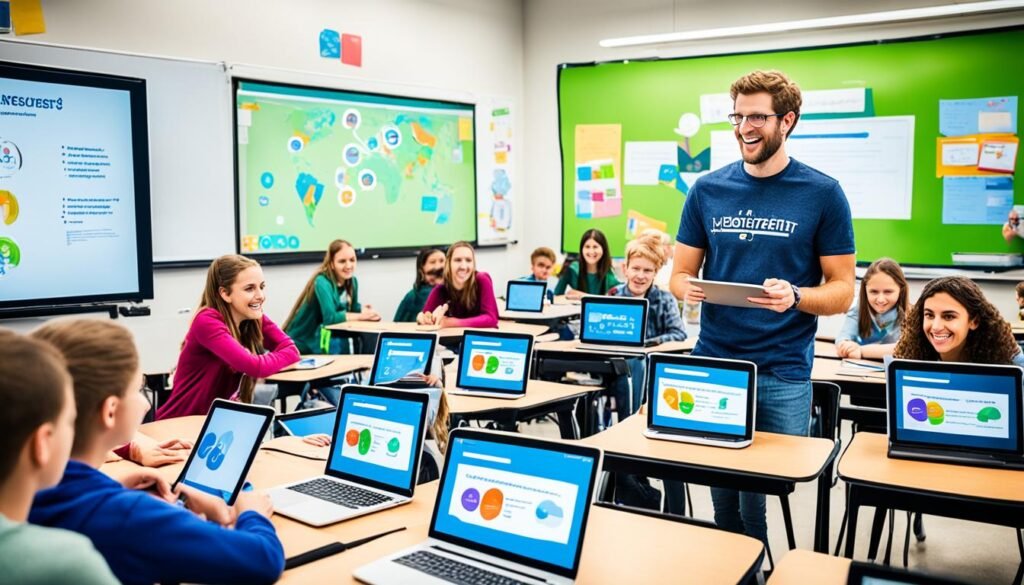
Looking at these stories and the feedback from parents and students, it’s clear. Technology makes learning better and prepares students for the future. Each story shows how technology is changing our schools for the better.
Conclusion
Technology in education is not just a plus; it’s a must for making learning fun, welcoming, and effective. This article showed how tech helps students get better information and tailor their learning. It also helps students work together better.
Each tech tool adds something special to a student’s education. It boosts their skills and gets them ready for the future. By using these tools, I can really make a difference in my kids’ learning.
They get the tools and help they need to do well in school. But, it’s important for teachers, parents, and school leaders to work together. This ensures we use technology to help students succeed.
As we move forward in education, using technology wisely is key to helping students do their best. It makes our job as supporters even more important. I’m excited to be part of this journey towards better learning with technology.
